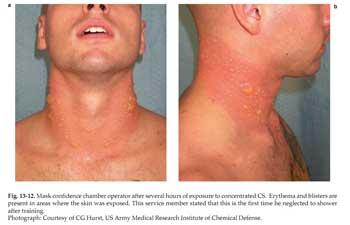Table of Contents
- Understanding the Effects of Pepper Spray on the Skin and Eyes
- Essential Safety Precautions Before Starting the Removal Process
- Step-by-Step Instructions for Cleaning Pepper Spray from Skin and Eyes
- Recommended Products and Aftercare Tips for Soothing Irritated Areas
- The Way Forward
Understanding the Effects of Pepper Spray on the Skin and Eyes
When pepper spray makes contact with the skin and eyes, its active ingredient, capsaicin, triggers an intense inflammatory response. This leads to immediate burning sensations, redness, and swelling as the body’s pain receptors become highly activated. The eyes, in particular, react with excessive tearing, temporary blindness, and a stinging discomfort, which can severely impair vision and cause panic. On the skin, the affected area might show redness and blistering, accompanied by a prickling or burning sensation that can last for hours if not properly treated.
Understanding these reactions clarifies why proper decontamination is crucial. While washing with water alone can sometimes spread the irritant, rinsing with specialized solutions or soaps that help break down the oily capsaicin molecule offers more relief. It’s important to avoid rubbing the affected areas, as that can worsen irritation. Helpful steps include:
- Using cool water and gentle pressure to rinse eyes and skin,
- Applying a mild, oil-based cleanser or soap to dissolve the capsaicin,
- Avoiding creams or ointments that may trap the irritant, and
- Seeking medical attention if symptoms persist or worsen beyond initial treatment.
Essential Safety Precautions Before Starting the Removal Process
Before you begin the removal process, it’s crucial to prioritize your safety to minimize discomfort and avoid further irritation. First and foremost, don’t touch your face, eyes, or any sensitive skin areas with contaminated hands or clothing. Wear protective gloves if available, and make sure you’re in a well-ventilated space to avoid inhaling lingering spray particles. Having a clean source of water nearby is essential, as immediate flushing of affected areas often neutralizes the irritants swiftly.
Additionally, prepare a few items that will ease the process and provide relief:
- Access to mild soap and lukewarm water for initial cleansing
- A gentle saline solution – especially useful for eye exposure
- Clean towels and disposable cloths to avoid recontamination
- Avoid oil- or alcohol-based products, which can exacerbate the burning sensation
Step-by-Step Instructions for Cleaning Pepper Spray from Skin and Eyes
Begin by rinsing the affected area thoroughly with cool water. For skin exposure, use a gentle flow of water to wash away the pepper spray residue without rubbing or scrubbing, as this may spread the irritant or worsen the discomfort. Avoid applying oils, creams, or lotions at this stage, as these can trap the chemical and prolong irritation. When dealing with eye exposure, keep the eyelids open and flush with clean, lukewarm water for at least 15 minutes, allowing the water to flow from the inside corner to the outside to prevent further contamination.
Next, use a mild soap or specialized cleanser formulated for removing oil-based irritants, if available, to help break down the residue on the skin. Be sure to gently pat dry the area with a clean towel, avoiding any vigorous rubbing. If irritation persists or if you experience severe pain, vision problems, or difficulty breathing, seek medical attention immediately. Remember, quick and careful action can significantly reduce the severity of pepper spray’s effects, so remain calm and methodical throughout the cleaning process.
Recommended Products and Aftercare Tips for Soothing Irritated Areas
After safely removing pepper spray, your skin may feel irritated, red, or even swollen. To calm these sensitive areas, consider using products formulated specifically for skin recovery. Look for gentle, fragrance-free cleansers to wash the affected zones initially, followed by soothing creams containing ingredients like aloe vera, calendula, or chamomile. These natural anti-inflammatory components help reduce redness and promote faster healing without causing further irritation. Avoid heavy lotions or anything with alcohol, as they may exacerbate the discomfort.
Alongside topical care, it’s important to maintain optimal skin hydration and protection. Applying a lightweight, hypoallergenic moisturizer several times a day will keep the skin barrier intact. Additionally, protect the irritated patches from sun exposure by wearing breathable clothing or using a broad-spectrum sunscreen designed for sensitive skin. Some recommended products include:
- Cetaphil Gentle Skin Cleanser – soap-free and ideal for sensitive skin
- Neutrogena Hydro Boost Gel-Cream – an ultra-hydrating, fragrance-free moisturizer
- Burt’s Bees Aloe & Coconut Oil After Sun Soother – cools and calms irritation
- EltaMD UV Clear Broad-Spectrum SPF 46 – protects without clogging pores or causing stinging
The Way Forward
Removing pepper spray safely is crucial to minimizing discomfort and preventing further irritation. By following the steps outlined in this guide-such as avoiding rubbing the affected areas, rinsing thoroughly with cool water, and using proper cleansing methods-you can effectively reduce the impact and recover more quickly. Remember, if symptoms persist or worsen, seeking medical attention is always the best course of action. Stay informed, stay prepared, and prioritize your safety. Thanks for reading, and stay safe out there!Check Our Other Blogs
- StunGun – Your Trusted Source for Stun Guns, Laws, and Self-Defense Tips
- PepperSprayLaws – Your Trusted Resource for Pepper Spray Information
- StunGunLaws – Your Trusted Guide to Stun Gun Legality and Safety




